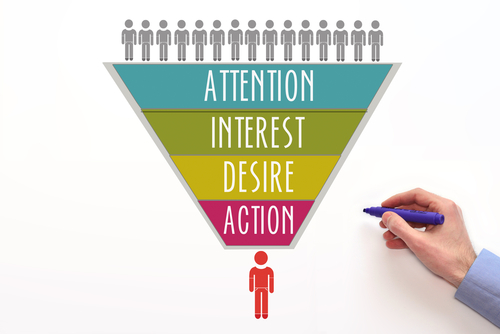 Reading Time: 4 minutes
Reading Time: 4 minutes
If you followed marketing news any time in the past several years, you’ve probably heard the AIDA acronym used in a few different contexts. It can often seem as if the topic of marketing inspires endless acronyms, all designed to improve business – if only you could remember them all. The meaning of AIDA remains the same no matter which aspect of business we’re discussing; however, the acronym frequently occurs in the context of content marketing and advertising.
What is AIDA? Why is it an important aspect of any advertising campaign? Most importantly, how can you use the components of the AIDA formula to improve your campaign and achieve a greater return on your marketing investment? Consider this brief guide to the AIDA formula for the answers to these questions and more.
What is AIDA?
AIDA is an acronym that stands for the four basic tenets of the AIDA model for marketing and advertising. Each tenet represents a stage the marketing campaign must take the consumer through to become a customer:
- Attention
- Interest
- Desire
- Action
AIDA is a hierarchy of effects model of the marketing funnel. Each consumer must pass through one stage to proceed to the next. For example, if you don’t first attract consumer attention, you have no hope of inspiring interest in your product or service, and certainly can’t expect them to take action and purchase an item that hasn’t inspired interest.
In this way, the hierarchy of effects mirrors the crucial marketing funnel – with each step, fewer consumers proceed toward final action for your product. Let’s say you capture the attention of 80% of your total audience with your initial advertisement, to the point where they desire to learn more about your offerings or your company as a whole. Then, only a portion of those with the desire will actually reach the tipping point and make the commitment to make a purchase. In this way, the AIDA formula narrows the number of consumers involved with your campaign until the final few convert into customers.
How You Can Use AIDA
As with any hierarchy, just as it is important for consumers to proceed through each level to become customers, it is important for you to understand each step. This way, you can successfully continue to inspire consumers to reach the crucial action stage, resulting in a purchase or other conversion.
- Attention. If you want consumers to gain the knowledge necessary to know where and how to purchase, you must first grab their attention. Just as in a piece of writing, attention must come first before the reader – or consumer, in this case – will give the rest of the piece a chance. To garner attention, you must research common problems, concerns, interests, and characteristics of your target market, and then craft your marketing campaign to address those aspects.
To attract attention to your campaign, you can begin your marketing strategies in places consumers normally direct attention, such as social media and television. The appearance of your marketing efforts – whether content marketing, traditional ads, media, or something else – draws the user’s attention simply because it is different from the surrounding content.
Alternatively, you can use an exciting, shocking, or provocative element within your content to capture attention. Elements can include a shocking headline, an intriguing photo, or the personalization of the ad toward the consumer’s own preferences. If you’ve effectively gotten the attention of the consumer, he or she is much more likely to continue to find out more information.
- Interest. Once you’ve captured the attention of consumers, the battle is not over. Now, you must hold consumer’s interest long enough to relay your most pertinent information, needed for the consumer to continue through the funnel. Depending on your service, product, or sector of business you may achieve this in multiple ways.Some marketers choose to use humor, provocative imagery, or personalization – strategies used in the initial attention-getting stage – to continue to hold consumer interest while relaying important information. Others focus on honing clear, concise, easy-to-use websites to display company information. No matter how you choose to hold interest, it is crucial to continue to move your consumers to the next stage in the AIDA hierarchy.
- Desire. If you’ve successfully grabbed consumer attention and held interest long enough to relay information about your product or service, you must now nurture consumer desire. Desire to know more about what your product has to offer can help generate a desire to see how that product can fit a need the consumer has.Promoting desire can include adding to the facts and features the consumer already knows about your product. Alternatively, you could be inciting a consumer to wonder how they have survived for so long without your service. At this point, you are effectively setting the stage for the consumer to make that final decision to take action.
- Action. Finally, after ensuring consumers know as much about you and your product or service as possible, they are nearly ready to take action. Your work is not done, however – you must still ensure that the idea to take action, that thought in the consumer’s head that “I would benefit from buying this product” – reaches fruition. This stage is where your call to action takes place.A final reminder to call, visit the website, or reach out in some way can take the form of an email reminder, a blurb at the end of a social media ad, or a targeted reminder of a sale. If the user is already on your homepage, mention of your current sale or an additional call to action can spur consumer action. Finally, ensuring your site or ordering system is as easy to use as possible helps promote seamless action by your newfound customers.
AIDA has been a consistently recognized method of converting consumers into customers since the late 1800s, when Elias St Elmo Lewis and other salesmen of the time recorded the strategy into the company books. Today, AIDA remains a tried-and-true formula that can help you move consumers through the buying journey.




